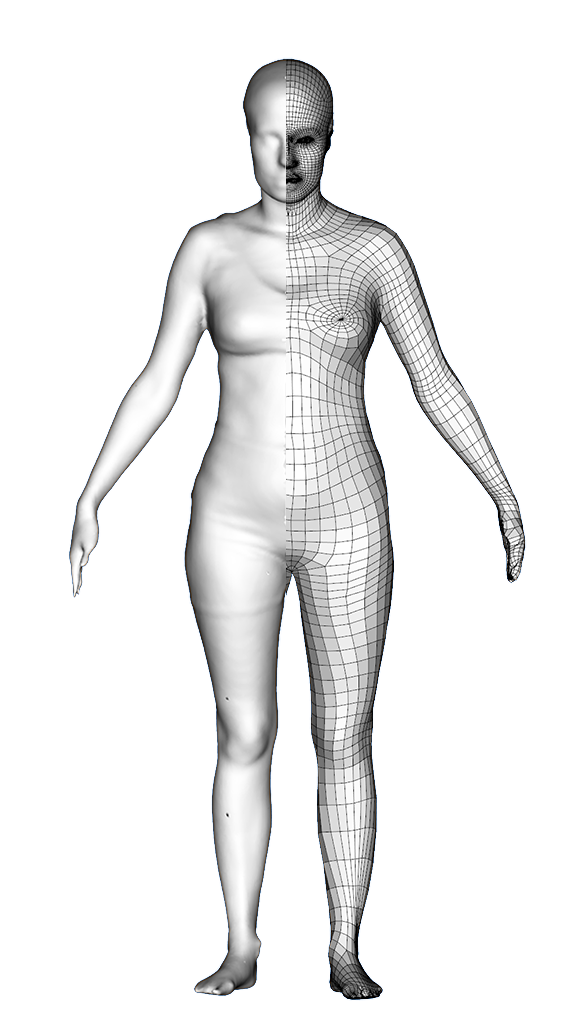Frequently Asked Questions
Click the questions below to see the answers.
Q: CAESAR was conducted nearly 25 years ago -- aren’t the CAESAR data out of date?
The CAESAR database is just as relevant and useful now as it was when first collected. The body sizes and shapes scanned then are still all present in today's population. Even at the time, the sample was not representative of the U.S. civilian population. So, from the beginning, it has always been necessary to weight the database (count some subjects more heavily than others) when estimating the size or shape of any population. But most applications of anthropometric data, including 3D shape data, do not require that the underlying data be representative of any population. Rather, the data should be diverse with respect to any variables of interest, and, in particular, to include a large range of body size and shape. See “Using CAESAR Data” below. Note that every U.S. dataset that is not weighted to match the U.S. government's NHANES data, the authoritative reference for U.S. body dimensions, is not representative and must be weighted for accurate modeling of the population. A dataset is not representative just because it is large, and no scan dataset can be truly representative due to the limitations of who can be scanned. Weighting is always necessary to obtain accurate population estimates.
Q: Why are the CAESAR data still valuable?
More than 25 years after the project began, the CAESAR data have not been superseded by any publicly available dataset. The advantages of CAESAR relative to other datasets include:
• large, diverse sample of civilians
• minimally clad individuals in multiple postures
• consistent and well controlled measurement process
• manually located body surface landmarks, including landmarks requiring palpation
• demographic information
• dozens of standard anthropometric dimensions
The availability of manually measured standard anthropometric dimensions is the most unusual aspect of this dataset. Most 3D scan datasets do not include standard anthropometric data, because it is difficult and time-consuming to collect and requires well-trained personnel. Yet, these dimensions are often the desired outcome of shape analyses, such as for clothing size prediction. The relationships between body shapes and standard dimensions are the same as when the data were gathered, even as the U.S. and other populations have changed.
Q: What is the download format?
Under license from
SAE International, we are making the CAESAR dataset publicly available in the identical form that it was provided to the original partners. Each partner received a box of compact disks containing sets of data (~200 subjects per disk). We have extracted and compressed the contents of each disk, so the downloads include the full, original dataset.
Q: What’s Included in the Database?
• 3D whole-body scans in 3 postures in a compressed (gzipped) PLY format
• landmark locations manually extracted from the scans
• manually measured anthropometric dimensions
• scan-extracted anthropometric dimensions
• demographic information
Q: How were the anthropometric variables measured?
The study methods are documented thoroughly in the official
report on the project and in the
Air Force report. Note that scan-derived measures are not necessarily consistent with manually measured dimensions with the same names.
Q: How can I use CAESAR data?
The potential uses of the data are limitless – the data are applicable to any design problem that would benefit from an accurate representation of human size and shape. Some common uses include:
• extracting dimensions for use in product design
• conducting “virtual fit tests” of clothing, equipment, seats, and other objects that come into contact with the body
• describing and sampling from the space of human body shapes
• creating avatars for use in CAD
As noted above, applications targeting a particular population (say, U.S. adults) will require reweighting or resampling of the data. If you have questions about how to weight the data or model outputs, please
contact us.
Q: The scan data are hard to use – can you make it easier?
A critical step in the use of unstructured scan data is fitting the point clouds with a homologous surface template to create an avatar. Once this step is completed, statistical analyses can be conducted, the avatar can be re-posed, and many other analyses are possible.
Due to the importance of this processing step, many methods for template fitting have been published, and some applications of CAESAR data have used the resulting avatars. Our methods include several advancements over some others, including incorporating accurate hands and feet. We are also able to remove the hair artifacts to make the head data much more useful for design.
We plan to make fitted avatars available during Summer 2023.
Q: Can I redistribute the CAESAR data? What about derived work?
The license for downloading the CAESAR data from the University of Michigan permits internal research and development usage. However, due to the restrictions of our license with SAE International, you may not redistribute the original data, whether in a software application or any other way, and you may not create a derivative work, or publish any material that would allow the database or any portion of it to be reconstructed or accessed. If you have any questions about your intended usage, please
contact us. Most applications, including commercial applications, can be accommodated with a modified license.







